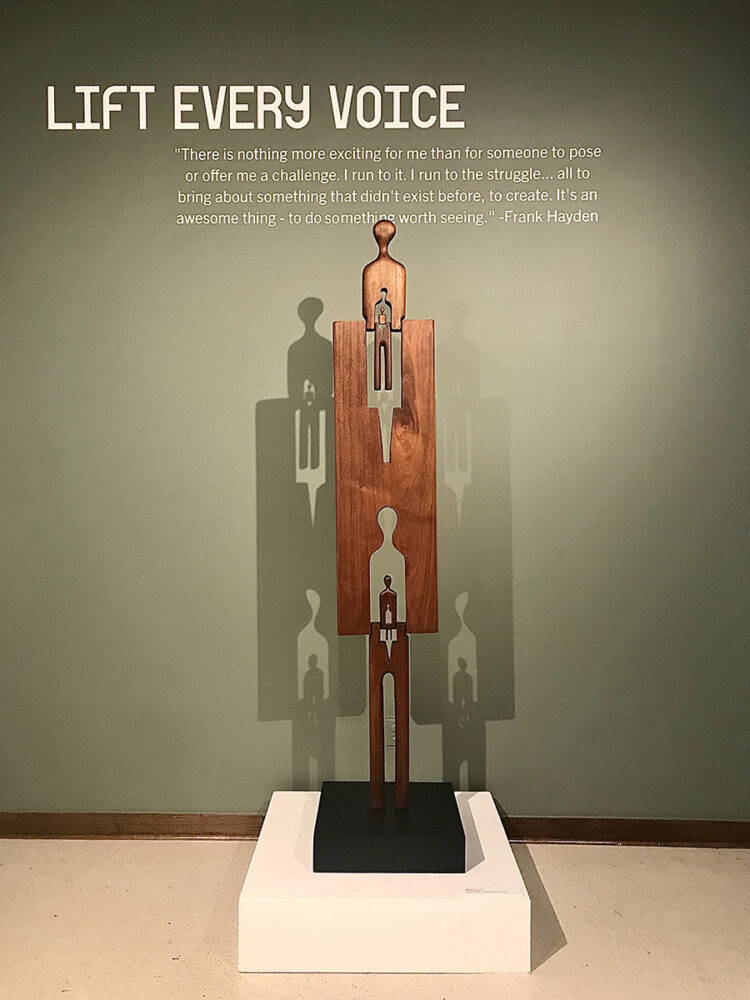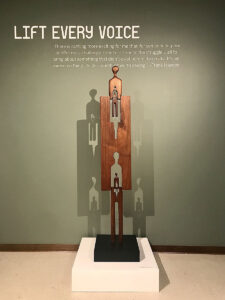Frank Hayden
Sculptor Frank Hayden often explored themes of fellowship, family, Christian values, war, and civil rights in his artwork.

Robin Miller
Installation view of "Negative/Positive" (1986) in "Frank Hayden: Lift Every Voice" exhibition (2020) curated by Elizabeth Chubbuck Weinstein for Louisiana Art & Science Museum, Baton Rouge.
Frank Hayden is among Louisiana’s preeminent sculptors. Hayden came of age during the tumultuous modern civil rights era. He grew up poor and struggled against discrimination as a Black artist. Yet he surmounted these obstacles and became one of Louisiana’s most acclaimed artists by the time he was thirty. Hayden received commissions to create sculpture for public spaces throughout Louisiana as well as other areas of the United States, including Pennsylvania, Virginia, and Indiana. The majority are in the Greater Baton Rouge area and continue to define the Capitol City’s landscape.
Hayden’s sculptural output reflects deep spiritual and humanistic concerns rooted in his Catholic faith. Fellowship, family, Christian values, war, and civil rights are common themes. Although his sculptures primarily represent figures, the forms are stylized and often abstracted. Words sometimes are inscribed across the surface. Hayden worked in clay, plaster, fiberglass, wood, bronze, and stone. In developing his personal style, he adopted aspects of European modernist art as well as elements found in African tribal arts.
Early Life and Education
Frank Hayden was born in Memphis, Tennessee, on June 10, 1934. He was five years old when his father died. His mother raised him and his sister on her own. He overcame a youthful speech impediment and went on to attend St. Augustine High School in Memphis. There the nuns taught Hayden to have a strong work ethic and a healthy respect for one’s fellow man. Recognizing his artistic abilities, the nuns encouraged him to enter art competitions, a practice that led to an academic scholarship at Xavier University in New Orleans. After spending a summer in Chicago, Illinois, Hayden arrived in Louisiana in the fall of 1953, the same year as the Baton Rouge bus boycott.
At Xavier, Hayden was introduced to sculpting and participated in national and regional ecclesiastic projects, creating murals and other public works. He established a lifelong friendship with fellow student John T. Scott who later became a renowned artist and sculptor, and was mentored by Angela Gregory, the first woman sculptor in Louisiana to gain international acclaim. Hayden graduated in 1957 with a BA in fine arts and a minor in German and was offered scholarships to ten graduate programs.
He chose to accept a scholarship to study under Ivan Meštrović at the University of Notre Dame in South Bend, Indiana. A Croatian sculptor, architect, and writer, Meštrović was highly regarded in Europe and America and proved to be a lasting influence upon the younger artist’s production. Hayden earned his MFA in 1959 and briefly taught at Iowa State University. While there, he was awarded a Fulbright Fellowship to study at the Munich Art Academy under liturgical sculptor Heinrich Kirchner. Hayden traveled to Europe again in 1964, this time on an American-Scandinavian Fellowship to study under sculptor Mogens Bᴓggild at the Royal Danish Academy of Fine Arts in Copenhagen, Denmark. A Henrik Kauffmann Award and a grant in 1968 from the Southern Fellowship Foundation enabled him to study at the Academy of Fine Arts in Stockholm, Sweden.
Teaching Career and Later Life
Frank Hayden moved to Baton Rouge in 1961 to join the faculty of Southern University, where he taught sculpture and drawing for the next twenty-six years. Among his many students were artists Morris Taft Thomas and Randell Henry. Hayden was honored in 1985 with Southern University’s first Distinguished Professor Award and two years later was presented with an honorary doctorate in the humanities degree from Madonna College in Livonia, Michigan. In addition to teaching, exhibiting his artwork, and carrying out sculpture commissions, Hayden served on the boards of many civic and educational organizations, both locally and nationally.
Hayden’s promising career was cut short tragically at age 53. He died on January 30, 1988, after being shot while asleep by his mentally ill son. In 1989 memorial exhibitions were held at the New Orleans Museum of Art and the Louisiana Art & Science Museum (then called the Louisiana Arts and Science Center). In 2020, the Louisiana Art & Science Museum staged a retrospective titled Frank Hayden: Lift Every Voice.
Legacy
Frank Hayden carried out numerous public art commissions for universities, commercial buildings, houses of worship, and outdoor civic spaces. He received his first public commission in 1956, a year before he completed his undergraduate education at Xavier. The majority are in the Greater Baton Rouge area. Among his best-known are the colossal ten-foot-tall bronze Head of Oliver Pollock accompanied by a thirty-foot long bronze frieze titled Marcha de Galvez. Both are located downtown in the Raising Cane’s River Center complex, which also houses City Hall. Dominating the Mississippi River levee nearby is Hayden’s Red Stick, commemorating Baton Rouge’s history. Among those on Southern University’s campus is another Red Stick and a memorial titled Lift Every Voice, honoring Leonard Brown and Denver Smith, two students who were killed during a protest on the campus in 1972. In New Orleans, Hayden’s bronze memorial to Dr. Martin Luther King Jr. is located at Oretha Castle Haley and Martin Luther King Boulevards. Commissioned by the City of New Orleans, it was dedicated in 1976. Among Hayden’s most personally rewarding commissions was a small statue depicting St. Martin de Porres, which was presented on behalf of the United States’s African American Roman Catholics to Pope John Paul II during his 1987 visit to Louisiana. Among Hayden’s last works was a white alabaster sculpture titled The Prodigal Son.
Frank Hayden’s work is held in many public and private collections, among them the New Orleans Museum of Art, Ogden Museum of Southern Art, and Xavier University in New Orleans; Louisiana Art & Science Museum, Louisiana State University Museum of Art, and Southern Univeristy Museum of Art in Baton Rouge; and DuSable Museum of African American History in Chicago.
